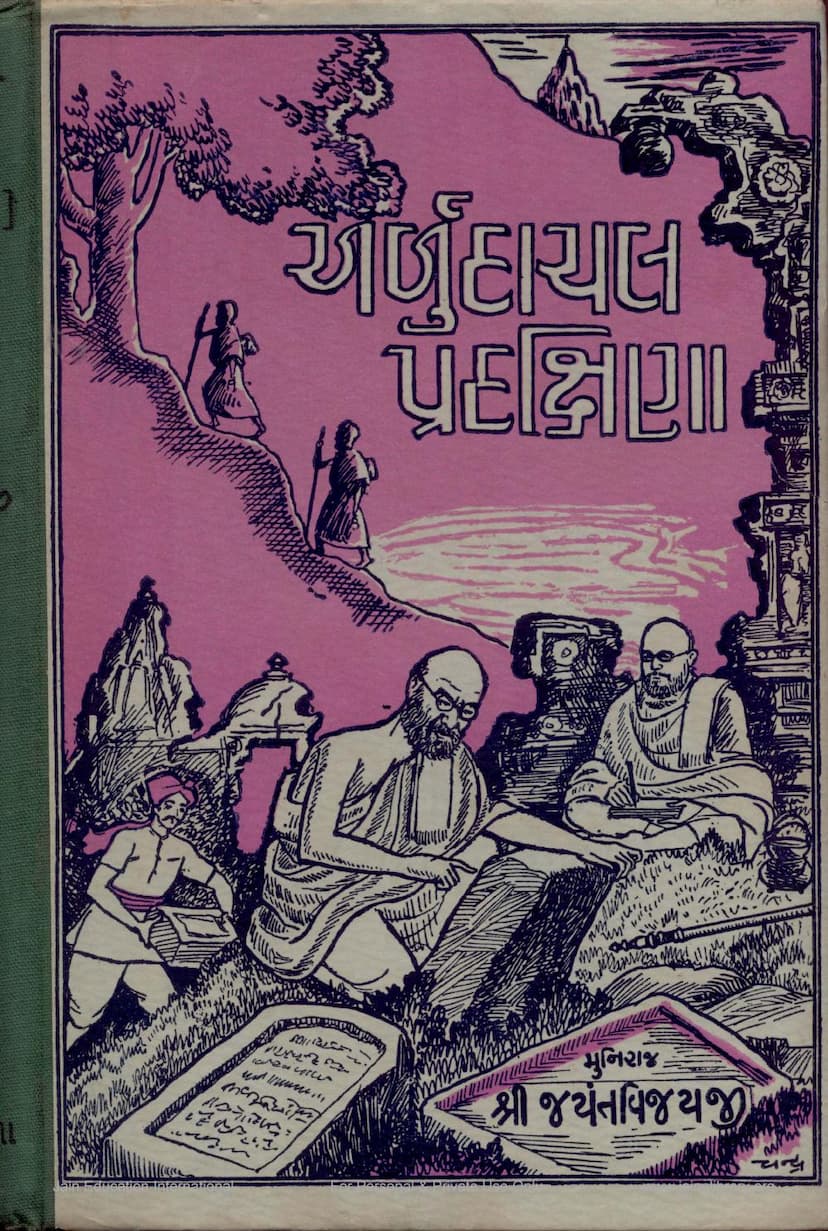Arbudachal Pradakshina Abu Part 04
Added to library: September 1, 2025

Summary
This is a comprehensive summary of the Jain text "Arbudachal Pradakshina Abu Part 04" by Muniraj Shri Jayantvijayji, published by Shri Yashavijay Jain Granthamala Bhavnagar.
Overall Scope:
This book is the fourth part of a series dedicated to the region around Mount Abu (Arbudachal). It meticulously documents the author's pilgrimage and detailed study of 97 villages surrounding the holy mountain. The focus is on the Jain temples, their current condition, inscriptions, history, and the Jain population in these villages. However, the author also includes descriptions of non-Jain ancient Hindu temples where relevant. The book is the result of over fifteen years of research, including the hardships of a mendicant's life and archaeological exploration.
Key Themes and Content:
-
Detailed Village Survey: The core of the book is a systematic survey of 97 villages around Mount Abu. For each village, the author provides information on:
- Location: Distance and direction from previous villages visited.
- Jain Temples: Number of temples, their condition (standing, ruined, empty), architectural features, and notable sculptures or images.
- Inscriptions: Carefully recorded inscriptions found at temples, pillars, platforms, caravanserais, etc., with accompanying annotations.
- Jain Population: The presence and number of Jain households, Upashrayas (monastic residences), Dharmashalas (guesthouses), and Jain schools.
- Non-Jain Temples/Sites: Descriptions of ancient Hindu temples and significant sites.
- Historical Context: Mention of ancient traditions, inscriptions on stone, historical accounts from texts, and the names of Acharyas who visited these places and celebrated festivals.
- Road Conditions: Brief descriptions of the paths and routes taken.
-
Inscriptions as Primary Sources: A significant portion of the book is dedicated to the collection and analysis of Jain inscriptions. The author emphasizes the importance of these inscriptions for historical and archaeological research, noting that a separate volume (Arbudachal Pradakshina Jain Lekh Samgrah - Abu Part 05) is being published containing these inscriptions with translations and analysis.
-
Author's Dedication and Methodology:
- Personal Experience: Muniraj Jayantvijayji highlights the arduous nature of his research, undertaken as a sadhu, often with only one disciple, enduring physical hardships to meticulously document every detail.
- Comprehensive Approach: He makes a conscious effort to cover both Jain and non-Jain historical sites, providing a holistic view of the region's past.
- Scholarly Rigor: The author refers to ancient texts, inscriptions, and even the works of other scholars like Pandit Gaurishankar Ojha, acknowledging his sources.
- Linguistic Nuances: In the introductory sections ("Kinchit Vaktavya" and "Khulase"), the author discusses specific linguistic interpretations, particularly regarding the term "Ladha Vishay" and "Jivit Swami," demonstrating his scholarly depth.
-
Historical and Architectural Significance of Abu:
- Artistic Heritage: The author is deeply impressed by the human intelligence and artistic prowess evident in the temples of Abu, particularly mentioning the contributions of Vimal Shah and the brothers Vastupal-Tejpal.
- Jain Influence: The text illustrates the significant presence and influence of Jainism in the region from the 10th to the 16th centuries, supported by the numerous temples and inscriptions.
- Decline and Preservation: The book subtly touches upon the decline of Jain population in some areas and the subsequent state of disrepair of some ancient temples, while also highlighting the efforts of patrons and communities in preserving this heritage.
-
Exploration of Jainism's Reach: The author draws a parallel between the past prominence of Jainism in Magadha and its later spread to Marwar and Western India, as evidenced by the dense Jain population and numerous temples found in these regions.
-
Detailed Accounts of Specific Villages/Temples: The summary provides a glimpse into the detailed descriptions of specific locations, such as:
- Kharadi: Mention of its railway station and road to Abu, a Jain dharamshala, and temples.
- Ambaji: A significant Hindu pilgrimage site described in relation to the Jain pilgrimage route.
- Kumbhariyaji: Praised for its five magnificent Jain temples with architecture rivaling Dilwara. Detailed descriptions of individual temples are provided.
- Mungthala: Described as a "Mahatirtha" with a grand Mahavir Swami temple, referred to as "JivitSwami," with significant inscriptions.
- Chandravati: Portrayed as a once-great city, now largely in ruins, with extensive historical accounts of its destruction and lost architectural grandeur.
- Hameergarh: A significant Tirth with a magnificent Jain temple, highlighting its ancient heritage and the impressive architectural details.
- Brahmanwada: Identified as a "Mahatirtha" and a "Jivit Swami" site, with detailed accounts of its temples, historical significance related to Lord Mahavir's presence, and the management of the pilgrimage site.
- Numerous other villages are described in similar detail, covering their temples, population, and any relevant historical or legendary information.
-
Errata and Clarifications: The book includes an "Errata" section to correct any printing errors and a "Kathanak" (Clarification) section to address specific points or interpretations, demonstrating the author's commitment to accuracy.
Publisher's Note:
The publisher expresses immense joy in releasing this meticulously prepared work, which took fifteen years of dedicated research. They acknowledge the author's extensive previous works on Abu and other Jain sites, praising his dedication and the value of his contributions to history and archaeology. They also mention the delay in publication due to wartime economic conditions but express gratitude for the assistance received.
Author's "Kinchit Vaktavya" (A Little to Say):
The author expresses that his visits to the temples of Mount Abu have always inspired him anew. He attributes the unique blend of natural beauty and human architectural achievement to an unknown inspiration. He spent years meticulously studying every sculptural work, delving into historical and mythological literature, and documenting all findings. He acknowledges that even after five volumes, he feels he hasn't fully captured the essence of Abu, and his sixth volume on praise-hymns is still in preparation.
Concluding Remarks:
"Arbudachal Pradakshina Abu Part 04" is an invaluable resource for anyone interested in the history, archaeology, art, and religious heritage of the Mount Abu region, particularly concerning Jainism. It's a testament to the author's dedication and the rich Jain legacy in India.